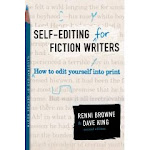If you decide to put foreign words in your fiction, it's best to italicize it the first time, but after that, leave it alone/don't italicize it.
When defining the foreign words in our prose, it's best not to stop everything for the definition.
Here's an example of what not to do:
He swung the parma. A short curved sword.
It's obvious that the writer it "telling" us what a "parma" is. Blaaack! All this does is remind our readers that they're "reading," pulling them out of the story by creating a speed bump.
Here's how to do it instead. The following keeps the story moving forward and doesn't stop the action.
He swung the parma, the short curved sword sliced into the enemy's armor.
See how we've defined the word "parma" without stopping the pace, without holding up the action? I love it when writers do this!
In the following example we have a Native American boy who is half white, speaking/thinking in Cheyenne.
He tied the knot fast and rubbed his hand along the soft fur. The skins would make a good muff for Grandmother this winter. He’d seen many white women wear them; they looked warm and his heveškemo deserved the best.
Notice here how we define the word "Grandmother" in the last line of the text.
Here's more:
He could still feel Mamma's hand in his. Could feel her letting go as the soldiers pulled her away. Could feel her stola ripping as he clutched it. All he had left was the shredded fabric from her dress still in his hand.
Here we know that stola means dress.
Another:
Titus ordered the new slaves to stand in the center of the atrium next to the impluvium. David ran his hand along the smooth edge of the large marble fountain that collected rainwater from an opening in the roof.
And another:
After the slaves were led away, and she was safe from being seen by Grandfather, she crept into the tablinum. She slipped through the heavy crimson curtain and into the small room between the atrium and the indoor courtyard.
She held her breath when she saw Grandmother and Aunt Fabia kneeling before the shrine. Usually they prayed in the morning.
Notice here how tablinum is defined in two paragraphs. The first by saying it's a small room between the atrium and the indoor courtyard. The second by showing what it's being used for: they're kneeling before the shrine. So, the reader sees that it's not only a small room, but it's a room with a shrine and where people pray.
Last but not least:
Before Grandmother could respond, Alethea slipped through the curtain on the other side of the tablinum and entered the peristyle. Flowers filled the indoor courtyard with a sweet fragrance. She especially liked the jasmine and breathed in its scent as she wandered between the plants and marble statues, following the patterns of flowers in the colorful mosaic on the floor.
This not only defines the peristyle, it shows us what it is.
Notice in all these examples how the writer also captures the emotion of the character/scene, rather than just stating a word's definition.
So, if you have foreign words in your manuscripts, have fun with them, don't just define them. Get creative, make them "move."
Tip: This can also apply to difficult words in children's fiction.
Monday, April 12, 2010
Subscribe to:
Post Comments (Atom)












Great post! I was impressed with how Sandra Byrd included French within her book "Let Them Eat Cake" and subtly "translated" it with another person's response.
ReplyDeleteWhat do you think of using a glossary?
Hi, Yvonne. Thanks for commenting!
ReplyDeleteIn all honesty (and this is just my opinion), I don't like glossaries. It's another way to cause a reader to stop reading (pulling them out of the story) to figure out what something means. Based on the examples above, it's really not necessary. I also don't believe in having so many foreign words in a story that it bogs down the prose so much that you HAVE to have a glossary.
Remember, we're storytellers. We want the prose to flow so smoothly that the reader "forgets they're reading" and loses themselves in our story. Making them stop to look up words, or making it obvious within the text that we're defining words, creates speedbumps and reminds the readers that "Hey! You're reading MY book. Yes, the one *I* wrote! Don't you LOVE it!" You see, it takes the reader's mind off the story and forces them to focus on the writer. :-)
Hope this helps!
Yes, I see what you mean. I have written a middle-grade novel about a young girl raised by a half-breed Indian. There are many authentic Algonquin words within it, including a lullabye. I made a glossary, but I think I could revise it to add the definitions within the storyline.
ReplyDeleteYvonne, yes try to add the definitions in the storyline. But also be careful that you don't use too many foreign words. They can overwhelm the reader to the point that they won't want to read the book.
ReplyDeleteAs for the song, that would be difficult to translate. You might be able to bring out the meaning of the words as she learns the language. Have the meaning unfold as the story unfolds. That'd especially work if the theme has anything to do with the song.
Hope this helps!
More thoughts: if it won't work to have the meaning of the song unfold with the story, then simply put the translation of it at the beginning or ending of the book. You know how some authors have a quote before their story starts? You could do it that way.
ReplyDeleteYou've given me some good ideas...now to get busy and utilize them. Thanks!
ReplyDeleteGreat tips on this!
ReplyDeleteThis is a great blog--I'm glad I found it! I wrote a novel set in Israel and used some typical Hebrew words but always in a way that showed or explained what they meant. And do you know, I still had a couple of people who complained or asked what certain words meant, even though I didn't have "that" many. :) I found out you can't expect everyone to figure things out on their own. I'm writing a sequel, and I'm going to treat the foreign words the same way--thank you for confirming this for me!
ReplyDeleteGlad it was helpful, Mid. :-)
ReplyDeleteIf some folks still complained that they couldn't understand, listen to that. Double-check how their meanings were defined. Perhaps they can be made more clear?
I am editing a book, in which one character resorts to talking in another language, because she doesn't speak English fluently. The author has translated what she says, and makes her 'speak' that too. Which looks very bad. But, how else can one explain to the reader what was said? Put it in brackets? Make some other character translate it? That stops the flow of the conversation. Any ideas?
ReplyDeleteThe best way is to write the dialogue in English and say she spoke in whatever language. Ex: "Don't do it," she said in Latin.
ReplyDelete